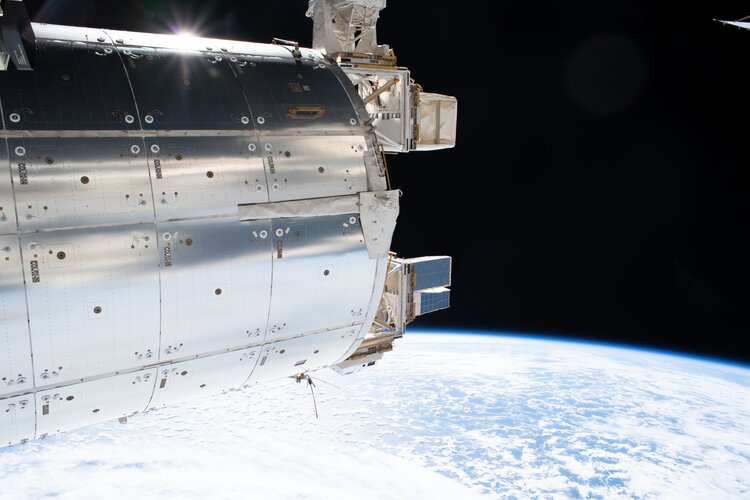
Copernical Team
Crown aurora borealis
 Video:
00:00:55
Video:
00:00:55
Timelapse video made during ESA astronaut Thomas Pesquet’s second mission to the International Space Station, “Alpha” around 4 November 2021. The camera was setup to take pictures at intervals of two a second, and the pictures are then edited into this video that plays at 25 pictures a second. The video is around 12 times faster than real speed.
Thomas shared this video on social media explaining that the pictures were taken from the docked Crew Dragon spacecraft windows and it was the strongest aurora the crew had seen during their six months ins space.
Over 200 experiments were
Space science in 360° | Cosmic Kiss
 Video:
00:00:00
Video:
00:00:00
Immerse yourself in 360° of science with ESA astronaut Matthias Maurer as he prepares an experiment to examine how human cells behave in weightlessness.
The Cytoskeleton experiment is a biological study that aims to determine the changing function of RhoGTPases when in vitro cell cultures are exposed to weightlessness. It will run in the Biolab facility of Europe’s Columbus laboratory.
In this video, we see Matthias remove Cytoskeleton cell cultures from the Minus Eighty Lab Freezer ISS (MELFI) and prepare them in the Life Sciences Glovebox (LSG) before installing the experiment in Columbus’s BioLab.
Matthias was launched to the International
Data-relay system connects astronauts direct to Europe

Astronauts on board the International Space Station are connecting straight to Europe at light speed, thanks to the European Data Relay System.
Watch Director General's annual press conference 2022

Watch live: our start-of-year press conference looking ahead at 2022, with ESA Director General Josef Aschbacher and ESA Directors, from 10:00 CET on 18 January.
Pixxel Partners with Rio Tinto to investigate benefits of hyperspectral satellite technology
 Earth imaging company Pixxel has announced an early adoption partnership with Rio Tinto. Pixxel's imaging satellites, capable of 5 meter hyperspectral imaging, will help Rio Tinto assess the benefits the technology may provide in mineral exploration, monitoring active and closed mine sites as well as track ESG indicators. Rio Tinto will begin its assessment of the technology following the releas
Earth imaging company Pixxel has announced an early adoption partnership with Rio Tinto. Pixxel's imaging satellites, capable of 5 meter hyperspectral imaging, will help Rio Tinto assess the benefits the technology may provide in mineral exploration, monitoring active and closed mine sites as well as track ESG indicators. Rio Tinto will begin its assessment of the technology following the releas Zero CO2 emissions 'spaceplane' parts to be manufactured in the heart of Sydney
 Aerospace engineering startup Hypersonix Launch Systems has signed a Master Research Collaboration Agreement (MRCA) with the University of Sydney to research and manufacture the components of a zero emissions, hypersonic spaceplane - a launch vehicle capable of deploying small satellites into low earth orbit (LEO).
Named Delta Velos, the vehicle will be powered by four green hydrogen-fuele
Aerospace engineering startup Hypersonix Launch Systems has signed a Master Research Collaboration Agreement (MRCA) with the University of Sydney to research and manufacture the components of a zero emissions, hypersonic spaceplane - a launch vehicle capable of deploying small satellites into low earth orbit (LEO).
Named Delta Velos, the vehicle will be powered by four green hydrogen-fuele Agency Addresses Hypersonic Vehicle Detection, Satellite Survivability
 The Space Development Agency will be fielding satellites that will provide eyes-on capability to detect maneuverable hypersonic glide vehicles during flight, and those satellites will be affordable and prolific, the SDA director said.
Speaking at the Mitchell Institute for Aerospace Studies' Schriever Spacepower Forum, Derek Tournear said satellites in low-Earth orbit, or LEO, will make up the
The Space Development Agency will be fielding satellites that will provide eyes-on capability to detect maneuverable hypersonic glide vehicles during flight, and those satellites will be affordable and prolific, the SDA director said.
Speaking at the Mitchell Institute for Aerospace Studies' Schriever Spacepower Forum, Derek Tournear said satellites in low-Earth orbit, or LEO, will make up the SES Government Solutions Launches On-Demand X-band Service Platform
 SES Government Solutions, a wholly-owned subsidiary of SES, announced the launch of tactiXs, a mission-specific managed service platform in partnership with Network Innovations and GovSat, a public-private joint venture between the Government of Luxembourg and SES.
The full end-to-end managed service provides practical, cost-effective solutions to mission parameters by allowing the custome
SES Government Solutions, a wholly-owned subsidiary of SES, announced the launch of tactiXs, a mission-specific managed service platform in partnership with Network Innovations and GovSat, a public-private joint venture between the Government of Luxembourg and SES.
The full end-to-end managed service provides practical, cost-effective solutions to mission parameters by allowing the custome Intelsat buys 2 Software-Defined Satellites from Thales Alenia Space to boost 5G solution
 Intelsat, operator of the world's largest integrated satellite and terrestrial network, and Thales Alenia Space, Joint Venture between Thales (67%) and Leonardo (33%) have signed an agreement to build two software-defined satellites designed to advance Intelsat's global fabric of software-defined GEO connectivity as part of its 5G software-defined network.
The addition of the Thales Alenia
Intelsat, operator of the world's largest integrated satellite and terrestrial network, and Thales Alenia Space, Joint Venture between Thales (67%) and Leonardo (33%) have signed an agreement to build two software-defined satellites designed to advance Intelsat's global fabric of software-defined GEO connectivity as part of its 5G software-defined network.
The addition of the Thales Alenia Understanding the "cold spot" in the cosmic microwave background
 After the Big Bang, the universe, glowing brightly, was opaque and so hot that atoms could not form. Eventually cooling down to about minus 454 degrees Fahrenheit (-270 degrees Celsius), much of the energy from the Big Bang took the form of light. This afterglow, known as the cosmic microwave background, can now be seen with telescopes at microwave frequencies invisible to human eyes. It has tin
After the Big Bang, the universe, glowing brightly, was opaque and so hot that atoms could not form. Eventually cooling down to about minus 454 degrees Fahrenheit (-270 degrees Celsius), much of the energy from the Big Bang took the form of light. This afterglow, known as the cosmic microwave background, can now be seen with telescopes at microwave frequencies invisible to human eyes. It has tin 